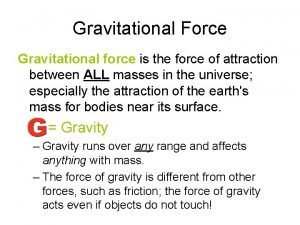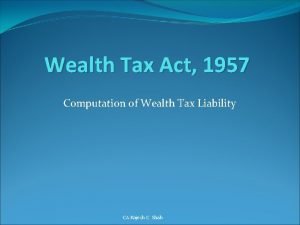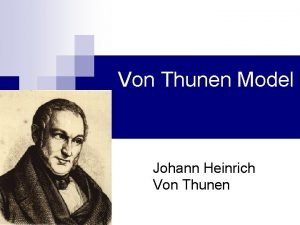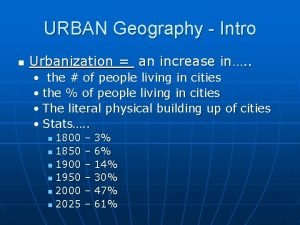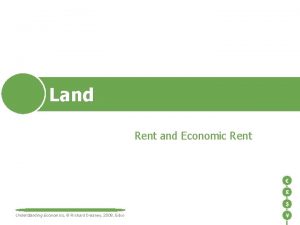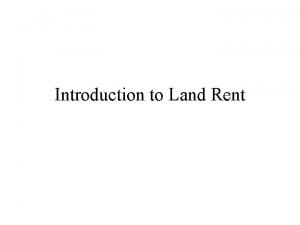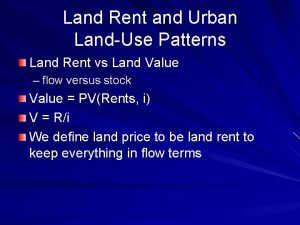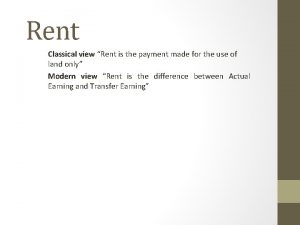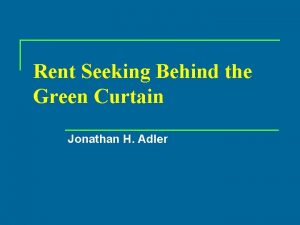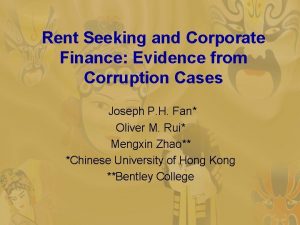Ground Rent Seeking in U S Economic History









![The legal basis of the European conquests • The Doctrine of [Christian] Discovery. • The legal basis of the European conquests • The Doctrine of [Christian] Discovery. •](https://slidetodoc.com/presentation_image_h/1dabf2762981fbc23d4c1da9b2bd742d/image-10.jpg)





























- Slides: 39

Ground Rent Seeking in U. S. Economic History by Fred E. Foldvary Economics, SJSU, 19 Sep. 2014

The meanings of “rent” * Rent as the yield of land (natural resources) * Economic rent: payments beyond what is needed to put a factor into its most productive use. All ground rent is economic rent. * Political rents: governmental subsidies, protection from competition, other privileges.

Why rent seeking? • Rent seeking: the attempt to obtain political rents. • Rent taking: successful rent seeking. • Rent seeking is at the expense of the public: taxpayers, consumers, investors. • The public has the great majority of votes. • Why does the public vote for politicians who provide political rents?

The disease of mass democracy • Public choice: concentrated benefits, spread out costs. • Mass democracy: elections in which very few voters personally know or have personal contact with candidates. • Mass democracy demand for huge campaign spending. • Special interests supply the funds in exchange for political rents. • One’s vote does not determine the outcome. One’s cost is small for any subsidy. Hence, voter apathy and ignorance.

19 th Century, U. S. small spending? • “democracy generates a mercantilist economy. ” Charles Rowley. • The US has had majoritarian mass democracy since its founding. • Public choice theory implies that the US should have had big spending for special interests during the 19 th century. • However, the 1800 s are regarded as an era of small government, with budgets balanced or in surpluses. • "For our first 60 years as a Nation…, cumulative budget surpluses and deficits yielded a net surplus of $70 million" (Office of Management and Budget). "Prior to the end of the Second World War there was no 'deficit problem'" (Gary Anderson, in Deficits).

Rent seeking in 19 th Century • Rent takings were indeed massive in 19 th century. • Not in money, but in land. • The public domain was an enormous stock of assets available for transfer to interests with clout, or as a way to spend without explicit taxation. • US land policy became an immense rent-seeking transfer program. • It was land-rent seeking. Land value = f(rent).

19 th century off-budget deficits • Haig-Simmons income: consumption + change in net worth. • It is “economic income, ” the implicit reality beneath the superficial appearance. • Spending greater than income: less net worth, a deficit. • The value of land grants from the public domain cancelled out the budget surpluses, and instead created an economic off-budget deficit (Anderson and Martin, 1987, "The Public Domain and Nineteenth Century Transfer Policy. " Cato Journal. )

Connection between tariffs and land • Northern industry sought protection from foreign competition. • Industrial protection-rent seekers wanted a tariff for both revenue and trade limitation. • Revenue from market-price land sales or leases would have funded government. • Giving away the land: political pressure for a revenue tariff. • Southern interests: sought to limit tariffs hence land giveaways.

Forms of land-rent political transfers • Types of land-rent granting and transfers: • 1) grants of land; • 2) public works which increase the rent and value of land; • 3) water licenses; • 4) leases for mineral, grazing, and forests below-market rates; • 5) the rental value of the electro-magnetic spectrum; • 6) airline routes, satellite orbits, and the genetic stock of life.
![The legal basis of the European conquests The Doctrine of Christian Discovery The legal basis of the European conquests • The Doctrine of [Christian] Discovery. •](https://slidetodoc.com/presentation_image_h/1dabf2762981fbc23d4c1da9b2bd742d/image-10.jpg)
The legal basis of the European conquests • The Doctrine of [Christian] Discovery. • 1455, Pope Nicholas V issues the papal bull, Romanus Pontifex. • This declaration justified the conquest of African lands by the king of Portugal. • No Biblical justification. • (Ecclesiastes 5: 9, “the profit of the earth is for all”. ) • Pope Alexander VI extended the Doctrine of Discovery to the Spanish conquests.

Christian Discovery in US law (not Constitution) • Under this doctrine, the first Christians to discover land held by non. Christians have a legally legitimate claim, and the indigenous dwellers have no legal property rights. • This Doctrine of [Christian] Discovery is “one of the rare principles of American law that came not from English common law or from the pen of some Enlightenment philosopher but rather from the Vatican. ” • Zebrowski, George. 2014. “Bully’s Justice. ” Free Inquiry 34(4). • The US Supreme Court recognized the Doctrine in Johnson v. M’Intosh in 1823 under Chief Justice John Marshall, and it was used in recent court cases regarding Indian claims to land.

British land policy prior to 1763 • Until 1763, England supported the interests of landowners. • Land grants were a primary inducement to the establishment of colonies and to emigration to North America. • Land companies “could make their venture profitable and enticing to important British officials by offering them shares of stock at special prices” (Curtis, 2014, “Riches, Real Estate, and Resistance: How Land Speculation, Debt, and Trade Monopolies Led to the American Revolution. ” American Journal of Economics and Sociology. )

The founders were land speculators • Leaders of the 1776 independence movement were land speculators: George Washington, George Mason, Thomas Jefferson, Patrick Henry, and Benjamin Franklin. • Speculation: the purchase of an asset, with the expectation of a favorable change in price due to a shift of supply or demand. • Land “was the outward sign and the economic foundation of the southern gentleman’s style of life” (Curtis). • The “westward migration and land speculation were necessities to the large plantation owners” (Curtis). The town merchants also used their wealth to finance their speculation in the frontier.

Land-seeking: a cause of American Revolution • Principled motives for liberty and republicanism played an important role, but were induced by economic motives. • Cobb (2014), “People. . . cloak their ambitions in universal ideals in order to attract support. ” • Political philosophical arguments “crowded out explanations based on self-interest. ” • “Political issues would not have been so thoroughly developed and expanded if the controversies over land tenure, regulation of western expansion, regulation of commercial activities, and taxation had not arisen” (Curtis).

Political rent seeking by Virginians • The wealthy Virginians especially had depended on land holdings in the frontier for their fortunes and social status, and they engaged in landed rent seeking: “the great planters. . . used their positions on the governor’s council or in the House of Burgesses to patent huge tracts of western lands” (Breen, 1985, “Tobacco Culture: The Mentality of the Great Tidewater Planters on the Eve of Revolution. ”) • “The colonial leaders would try to interest politically important Englishmen in specific land schemes, hoping that these men might be able to help them get the blessing of the Crown in the form of a land grant” (Curtis).

1763: UK Changes its Land Policy • Seven Years’ War (The French and Indian War), 1754 -1763. • The British defeat the French. Treaty of Paris, 1763. • The Royal Proclamation of 1763 by King George III. • The UK gets French North America, Quebec. • Britain’s land policies in America became more restrictive. • Wealthy land interests lose their political and economic clout. • “A complete reversal of the previous English land policy” (Curtis).

The Quebec Act of 1774 • Extended the territory of Quebec south. • To appease the Québécoise and keep peace with the Indians. • Prevented Americans from continuing to move into western lands they regarded as properly theirs. • Voided the sea-to-sea claims of colonies such as Virginia. • Made worthless the claims of speculators including Benjamin Franklin, George Washington, and Patrick Henry. • Grievances were inscribed in the Declaration of Independence. • That the king prevented the migration into and “new appropriation of lands” and had altered the land charters. • Economic complaints were politicized in the Declaration.

British land policy unified American colonists • The new British land policies “tied the economic interest classes together and brought the agrarian masses into the struggle on the side of the revolutionaries. ”

Ground-rent seeking created the Constitution • Charles Beard (1913. An Economic Interpretation of the Constitution) identified three key interest groups that supported the Constitutional Convention: • money lenders, protection-seeking manufacturers, and land speculators. • A key advantage of the Constitution to the land seekers was that it would empower the central government to take the Indian lands with its national army.

The 19 th-century disposition of US land • The U. S. government disposed of 871 million acres of land. • Virginia handed over much of Kentucky to insiders by 1783, which led settlers to secession. • This Kentucky episode was of national significance. • Friedenberg, Daniel. 1992. Life, Liberty, and the Pursuit of Land. • “The entire political structure of the United States, from the lower levels of state legislatures and governors to the U. S. legislature and then the Supreme Court and presidency, was fueled for many decades thereafter by money made in this [Kentucky] land speculation. ”

Southern lands • Large land holdings in Kentucky and other new southern states entrenched the institution of slavery. • Had these lands been settled and owned by small farmers, the history of the south would have been substantially different. • In Georgia, the Yazoo companies obtained grants of over 25 million acres in 1789, comprising most of Alabama and Mississippi, for $200, 000. • Yazoo lands were sold by the Georgia legislature for less than two cents an acre, and then resold in the form of scrip to thousands of gullible investors. Huge fortunes were made in such swindles, often by some of the most respected names in government.

Effects on settlement and agriculture • The speculative demand increased land prices and thus hindered settlement by those who lacked the means to purchase land. • Speculative purchases held land out of the market for at least a time and so compelled settlement to pass around or across it. • Agriculture was often held back, since speculation was regarded as more profitable until the bulk of the land was claimed. • Government policy facilitated it because many officials were involved. “Many members of Congress were deeply involved in land speculation" (Benjamin Hibbard, 1924, A History of the Public Land Sales).

Public works subsidize land values • Much land speculation in the U. S. was related to government public works projects, which greatly increase the value of the land serviced. • In the 1830 s, the stimulus was canal building. • The success of the Erie Canal in New York State and the rapid rise of land values along its route led to the extension of the same speculative calculations to Chicago when a canal linking Lake Michigan to the Mississippi River was proposed. • The Black Hawk Indians were subdued by federal and local troops in 1832, sparking a rush of settlers to Chicago (Hoyt, 1933, One Hundred Years of Land Values in Chicago).

Land, bank panics, and depression • President Jackson issued the specie circular of July 11, 1836, requiring payment for land in gold and silver. • On May 29, 1837, the Illinois banks suspended specie payments, backed by a special act of the legislature. • It became impossible to borrow money on real estate or to renew existing loans. The panic of 1837 became a national depression. • Real estate prices collapsed. Debtors defaulted. Chicago land purchased for $11, 000 an acre in 1836 sold for less than $100 in 1840. • Land policy was thus a root cause of the depression.

The Homestead Act of 1862. • The South had blocked free grants to settlers, fearing an increase in the population of the non-slave lands. • After the Civil War began, the Homestead Act of 1862 was passed. • It granted citizens the right to own up to 160 acres at $1. 25 or $2. 50, depending on its quality, on the condition of cultivating it. • But most lands were granted to corporations and non-cultivating individuals for a few cents per acre (Henry George, 1871. Our Land Policy, National and State).

Circumventing homesteading. • "Cattlemen and speculators, both large and small, made widespread use of the 'dummy entryman' trick and other ruses to acquire holdings far in excess of 160 acres, and the Land Office lacked either the will or the ability to stop them" Peter Barnes. 1971. "The Great American Land Grab. " Serially, The New Republic. • There were public sales before lands were settled. Speculators were thus able to obtain choice lands at low prices, often circumventing the law. "By means of cabins built on wheels or at the intersection of quarter section lines, and false affidavits, a good deal of land grabbing has also been done under the pre-emption and homestead laws" (George, 1871).

Grants to veterans. • Most grants of land by the federal government to individuals went to war veterans, amounting to 78 million acres. • Land payments to veterans began with the Revolutionary War, with soldiers paid in script for claims on western land. • The land debt in turn created pressure to kill and remove the Indians, which required a strong national government (Friedenberg). • The plantation and patroon lords used State-backed paper money to buy up the confiscated Loyalist lands.

Land to veterans and colleges • Congress rewarded veterans of the War of 1812 and the Mexican War with land in Ohio, Michigan, Illinois, Maryland, and Arkansas. • The transfers were in the form of warrants for land, almost all of which were sold to land speculators rather than exercised for land. • The Agricultural College grant was enacted in 1862. • The States were given 30, 000 acres for each Senator and Representative. States such as New York lacking in federal lands obtained land in other States.

The railroad land grants • For example, the Pacific Railroad bill of 1862 gave the Union, Central, and Kansas rail companies ten sections (one square mile, or 640 acres) of land per mile, doubled in 1864 to 20 sections, or 12, 800 acres per mile of railroad. • Railroad companies also obtained the privilege of cutting timber on government land. • These assets were far in excess of the cost of building the railroads by private firms, financed by the investors. • The lands obtained appreciated in value, adding to the gain by the railroads. At $20 per acre, the land grants amount to half a million dollars per mile of railroad, or over $1. 1 billion to the Northern Pacific for a railroad costing it $80 million. The company's own publication stated that it would have a surplus even at $2 per acre.

Land transfers in California • Lasting effect: concentration. 3. 7 million acres of California farmland are owned by 45 corporate farms. Nearly half of the agricultural land in the state and about three-quarters of the prime irrigated land. • Mexican land grants inherited from Spanish grants. • Mexican grant holders were taken advantage of by land speculators and their lawyers. Most of the grants passed on to other owners. • The holders of the bogus grants drove off settlers, backed by the sheriff and U. S. troops.

California land takings • Much of the best valley land in California was granted to the railroads. Although they received alternate sections, in practice the lands were not marked, and homestead settlers could not determine what land was government and what was railroad land. • Where land was surveyed and marked, the "vaqueros" or cowboys working for the railroads pulled up the stakes (George, 1871). • Settlers at a land office would be put off while the land they wanted was acquired by a speculator, and the settler would then be referred to him for purchase • Lands granted to the railroads for the purpose of enhancing settlement instead hampered it.

Row, row your boat, and get land! • Henry Miller's acquisitions illustrate the methods used. The Swamp Lands Act provided lands to individuals free of charge if they would agree to drain them. "The law provided that the land had to be underwater and traversable only by boat. Miller loaded a rowboat onto the back end of a wagon and had a team of horses pull him and his dinghy across his desired grassland. Eventually the government received a map of the territory from Miller, together with a sworn statement that he had crossed in a boat. Thousands of acres thus became his" (Barnes, 1971).

Ground rent seeking via capitalization • Adam Smith in the Wealth of Nations: "Every improvement in the circumstances of society tends either directly or indirectly to raise the real rent of land, to increase the wealth of the landlord. ” • The rental value of land, and its sales price, is increased by externalities that add to the demand to be located at some site, when the public works and civic services are paid for by others. • Once granted, capitalized values become a powerful political force in resisting any reduction in the subsidy, since that decreases the value and yield of the land.

Lasting effects of ground-rent taking • Opportunity cost: revenues that could have been obtained from market-priced land sales or leases, substitutes for market-hampering taxation. • A politically based cause of economic inequality and concentration. • Fiscal and monetary land-value subsidies fuel real estate bubbles that result in recessions and depressions such as the Crash of 2008. • Induces continuing rent-seeking and corruption.

Did land-rent seeking change economic science? • Cornell University, named for Ezra Cornell, founder of Western Union. Both Ezra Cornell and the Cornell University held massive amounts of western land. • Alvin S. Johnson of Columbia University, a student of J. B. Clark, was hired by Cornell University. Johnson introduced a new meaning of "rent" as a return to land to any surplus over opportunity cost. Johnson, Alvin S. 1902. Rent in Modern Economic Theory. • The blending of returns from land capital (real and financial) was part of the neoclassical turn. The classical 3 -factor school became the neoclassical two-factor school. Y=f(K, L). K is homogenous.

Land rent gets generalized and hidden • Mason Gaffney writes that the administrators of Cornell University "hired someone to defend their position as absentee land speculators. “ • Johnson was a mentor of Frank Knight at Cornell and through Knight influenced the Chicago School. • Johnson's defense of land-rent seeking coincides with his theoretical obfuscation of the concept of land rent, which then permeated neoclassical economics. Gaffney, 1994, The Corruption of Economics. • Johnson's defense of land-rent seeking coincides with his theoretical obfuscation of the concept of land rent, which then permeated neoclassical economics. Herein may lie some clues as to why land rent takings continue with little knowledge or concern by economists.

How much is land rent?

How to cure the disease of rent seeking • The cause of rent seeking is the structure of governance, mass democracy. • Constitutional constraints on mass democracy have failed. • The remedy is the replacement of large-group voting with small-group voting. • Divided the political body into tiny neighborhood cells.

Cellular democracy • The incentive for group action diminishes as group size increases, so that large groups are less able to act in their common interest than small ones (Moncur Olson, The Logic of Collective Action). • The neighborhood cell of about 1000 persons enables personal campaigning at little cost. • Voting only for a neighborhood council reduces voter ignorance. • Neighborhood councils elect higher-level councils, etc. • Each level is monitored by the level that elected it. • Representatives can be easily replaced. • Bottom-up multi-level governance not sufficient, but necessary.
 Economic growth vs economic development
Economic growth vs economic development Difference between economic growth and economic development
Difference between economic growth and economic development Chapter 1 lesson 2 our economic choices worksheet answers
Chapter 1 lesson 2 our economic choices worksheet answers Brazil economic history timeline
Brazil economic history timeline Replacement behaviors for attention seeking
Replacement behaviors for attention seeking Who said this line
Who said this line Sensation seeking
Sensation seeking Seeking safety worksheets
Seeking safety worksheets Range card class powerpoint
Range card class powerpoint Power seeking
Power seeking Trait theory consumer behaviour
Trait theory consumer behaviour Netflix policy
Netflix policy Sensation seeking significato
Sensation seeking significato Letter of enquiry format
Letter of enquiry format Habit no 5
Habit no 5 Center seeking force
Center seeking force A place where you may obtain employment milady
A place where you may obtain employment milady Seeking the old paths
Seeking the old paths Manufacturers seeking distributors
Manufacturers seeking distributors Seeking more knowledge
Seeking more knowledge Grounding seeking safety
Grounding seeking safety Nursing diagnosis of lung cancer
Nursing diagnosis of lung cancer Information seeking strategies
Information seeking strategies Observatiematrix
Observatiematrix Dialogue asking permission
Dialogue asking permission Colossians 3:2 sermon
Colossians 3:2 sermon Goal seeking analysis in dss
Goal seeking analysis in dss Novelty seeking
Novelty seeking Wives want nsa kiowa
Wives want nsa kiowa Information seeking behaviour definition
Information seeking behaviour definition Just seeking peace 0921
Just seeking peace 0921 What is gravitation
What is gravitation Information seeking in business
Information seeking in business Computation of wealth tax
Computation of wealth tax Bid rent theory
Bid rent theory Ranching definition ap human geography
Ranching definition ap human geography Multiple nuclei model definition geography
Multiple nuclei model definition geography Bid rent theory example
Bid rent theory example Urban sprawl aphug
Urban sprawl aphug Bid rent curve ap human geography
Bid rent curve ap human geography































